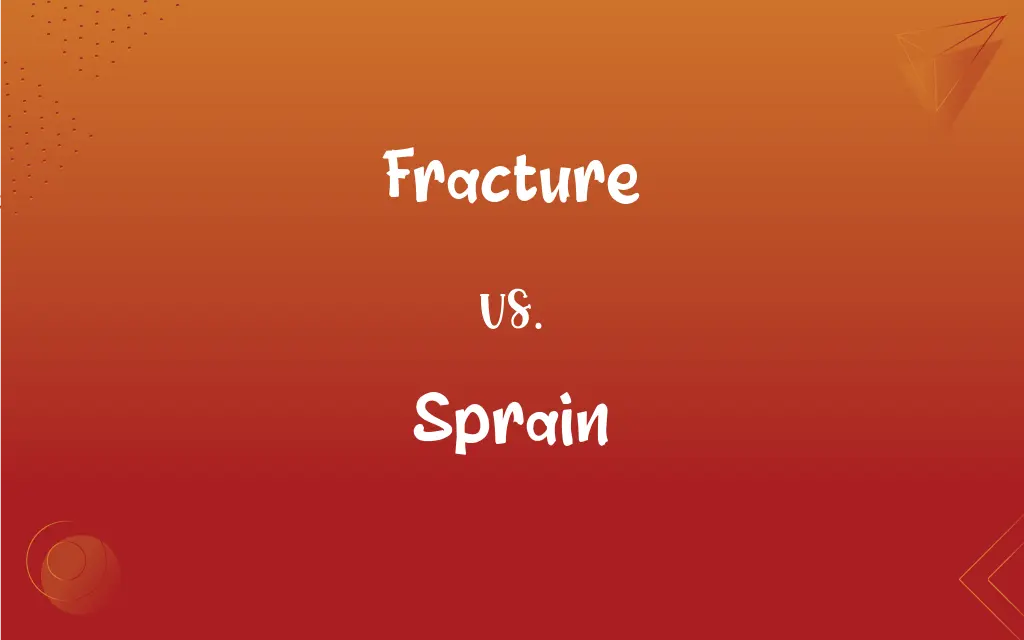Fracture vs. Sprain: What's the Difference?
Edited by Janet White || By Harlon Moss || Updated on October 27, 2023
Fracture refers to a break in a bone. Sprain refers to an injury to a ligament caused by overstretching or tearing.

Key Differences
Fracture refers to a break or crack in a bone, while a sprain is an injury to ligaments, the fibrous tissue connecting bones.
Fractures can range from minor cracks to complete breaks. Sprains involve the stretching or tearing of ligaments and can vary in severity.
The diagnosis of a fracture often requires an X-ray to visualize the bone break. A sprain is usually diagnosed based on physical examination and symptoms.
Healing a fracture often involves immobilization, such as with a cast. Treatment for a sprain may include rest, ice, compression, and elevation (RICE).
Common causes of a fracture include falls, trauma, or osteoporosis. Sprains are commonly caused by sudden twisting or turning motions.
ADVERTISEMENT
Comparison Chart
Part of Speech
Noun, Verb (to fracture)
Noun, Verb (to sprain)
Word Origin
Latin (fractura)
Middle English (spraynen)
Plural Form
Fractures
Sprains
Adjective Form
Fractured (broken)
Sprained (injured)
Related Terms
Fracture line, Hairline fracture
Sprain severity, Ankle sprain
ADVERTISEMENT
Fracture and Sprain Definitions
Fracture
A break in the continuity of a bone.
She suffered a fracture in her wrist from the fall.
Sprain
A wrench or twist of the ligaments of a joint.
She felt a sprain in her wrist after lifting the heavy box.
Fracture
The act of breaking or cracking something.
The earthquake caused the fracture of several building foundations.
Sprain
An act of overstretching or injuring a joint.
The gymnast's sudden fall resulted in a sprain.
Fracture
The breaking of a mineral along natural lines.
The geologist observed the characteristic fracture of the quartz crystal.
Sprain
Damage to ligaments from excessive force.
The skier suffered a sprain when her ski twisted awkwardly.
Fracture
A crack or break in a hard object or material.
The vase had a noticeable fracture on its surface.
Sprain
An injury to a ligament caused by stretching or tearing.
He got a sprain in his ankle playing basketball.
Fracture
A division or split in a group or organization.
The controversial decision led to a fracture within the committee.
Sprain
A condition of being strained or twisted.
The awkward landing caused a sprain in her knee.
Fracture
The act or process of breaking.
Sprain
A painful wrenching or laceration of the ligaments of a joint.
FAQs
How is a fracture diagnosed?
Often through an X-ray or other imaging tests.
What is a sprain?
An injury to a ligament caused by overstretching or tearing.
What is a fracture?
A break or crack in a bone.
Are sprains always severe?
No, sprains can vary from mild to severe.
Can fractures be minor?
Yes, fractures can range from small cracks to complete breaks.
What's the usual treatment for a sprain?
Commonly rest, ice, compression, and elevation (RICE).
Can a sprain lead to long-term issues?
Severe sprains can lead to instability or long-term joint issues.
What activities commonly cause sprains?
Sports, falls, and sudden twisting motions.
Do sprains heal on their own?
Many mild sprains can heal with proper care and rest.
Do sprains swell?
Yes, sprains often cause swelling and bruising.
How long does a fracture take to heal?
It can vary, but typically several weeks to months.
Can you walk on a sprained ankle?
It depends on the severity, but walking can be difficult and painful.
Do fractures require a cast?
Many, but not all, fractures are treated with immobilization like a cast.
What are common causes of fractures?
Falls, impacts, accidents, and conditions like osteoporosis.
Can a sprain recur?
Yes, especially if the ligaments are weakened from previous injuries.
Are fractures more serious than sprains?
Generally, fractures are considered more serious, but it depends on the severity.
Is a sprain a tear?
A sprain can involve tearing of the ligaments.
Can children get fractures easily?
Children's bones are more flexible but can still fracture.
Are there different types of fractures?
Yes, including stress fractures, compound fractures, and others.
Can you move a limb with a fracture?
Movement can be difficult and painful depending on the fracture.
About Author
Written by
Harlon MossHarlon is a seasoned quality moderator and accomplished content writer for Difference Wiki. An alumnus of the prestigious University of California, he earned his degree in Computer Science. Leveraging his academic background, Harlon brings a meticulous and informed perspective to his work, ensuring content accuracy and excellence.
Edited by
Janet WhiteJanet White has been an esteemed writer and blogger for Difference Wiki. Holding a Master's degree in Science and Medical Journalism from the prestigious Boston University, she has consistently demonstrated her expertise and passion for her field. When she's not immersed in her work, Janet relishes her time exercising, delving into a good book, and cherishing moments with friends and family.
































































